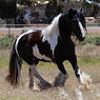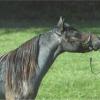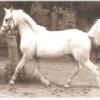Black Forest Horse
Forums
Re: Black Forest Horse
I don't know, I think most look like obvious chestnuts, but then silver doesn't seem completely unusual in Europe so silver definately possible too? The more red ones don't look silver bay either like these Comtois I was looking at. So I'm inclined to think the Black Forests aren't silver. If some were silver, then wouldn't we see some black/bay foals appearing too?
On the silver note with Comtois, if so many of them are silver, then shouldn't they have homozygous silvers and thus be good to do a silver/ASD study with??
[quote="Danni"]Hey a bit off topic but does anyone know what these silver bay looking horses are?? The heavier ones are chunkyish a bit like a Belgian which why I thought of them.
http://www.flickr.com/photos/gypsy_cob/…" onclick="window.open(this.href);return false;
http://www.flickr.com/photos/gypsy_cob/…" onclick="window.open(this.href);return false;
http://www.flickr.com/photos/gypsy_cob/…" onclick="window.open(this.href);return false;
[quote="Dogrose"]They are Comtois, I'm 100% certain they have silver, I've seen too many picutes where it is obvious. They are always described as chestnut. I have seen pics of black based, brown based and bay based silver Comtois, silver black and silver bay Comtois crosses and plain bay Comtois, mostly on French slaughter rescue message boards. I think Comtois are fairly small for draughts, about 14.2 ish usually? Or a little more.[/quote][/quote]
Re: Black Forest Horse
I couldn't find any foal photos, but many bay/brown silver foals look very red at birth.
The first many photos that come up when I search Black Forest are all silvers. *shrugs*
IE:
[img]http://www.theequinest.com/images/black…]
Re: Black Forest Horse
Look at the different gallery photos...
http://www.blackforesthorse.com/gallery…" onclick="window.open(this.href);return false;
The baby silvers I've seen are more greyish then red though I know you can't ever judge foal coats. LOL
Re: Black Forest Horse
Of all the pictures I saw though Acc, there was only those two pictures and a couple of others that looked more silver. The rest looked very chestnut. That second picture is from the farm in the US I think, here is more of their pictures.
[img]http://www.blackforesthorse.com/images/…]
Thos colt was sired by the second horse in your post Acc, out of the mare below.
[img]http://www.blackforesthorse.com/images/…]
This is one of the darker mares, she's a bit darker at the knees than most so could be silver, but I don't really think she is?
[img]http://www.blackforesthorse.com/images/…]
Here she is again with a foal
[img]http://www.blackforesthorse.com/images/…]
One of their colts
[img]http://www.blackforesthorse.com/images/…]
Anyway heaps more pictures there, but you get the idea.
Cheers
Danni
Re: Black Forest Horse
[quote="Andrea"]Look at the different gallery photos...
http://www.blackforesthorse.com/gallery…" onclick="window.open(this.href);return false;
The baby silvers I've seen are more greyish then red though I know you can't ever judge foal coats. LOL[/quote]
Yeh that's the colt by the dark stallion in Accs post. Here he is at his darkest I think, and still looks dark chestnut to me?
Re: Black Forest Horse
[quote="Danni"]On the silver note with Comtois, if so many of them are silver, then shouldn't they have homozygous silvers and thus be good to do a silver/ASD study with??[/quote]
As soon as I get money, I'd be happy to go investigate. On that topic, I'd like to mention that every silver horse that I have examined since I started this research has at least had ciliary cysts.
Re: Black Forest Horse
[quote="Monsterpony"][quote="Danni"]On the silver note with Comtois, if so many of them are silver, then shouldn't they have homozygous silvers and thus be good to do a silver/ASD study with??[/quote]
As soon as I get money, I'd be happy to go investigate. On that topic, I'd like to mention that every silver horse that I have examined since I started this research has at least had ciliary cysts.[/quote]
I'd love to see what you find out! I never had much faith in the original research but it looks like much more is being found out now. Not that I have any idea how you see if a horse has ciliary cysts or not! :oops: So has more recent research actually looked more closely at tested silvers in all breeds?
Re: Black Forest Horse
Have you been testing red based silver carriers as well?
Some of those do look very live chestnut/flaxen but that pic of the stallion facing/truning away from the camera shows black looking hair below the knee at the top of the cannon. Could they be silver bay with a strong pangare?
Re: Black Forest Horse
Yeh I don't think the one being ridden is silver, he's kind of reddish at the top of his tail and I'd expect it to be either diluted, or more black?
Dunno about the other one, I've seen non silvers that colour, but he looks silver too. I can't tell the difference :oops:
Re: Black Forest Horse
[quote="lillith"]Have you been testing red based silver carriers as well? [/quote]
I did look at chestnut filly out of a silver bay mare, but only with a flashlight so didn't good look. Otherwise, very few people that I have run into with silvers know anything about it. And I didn't run into another chestnut that I knew was out of a silver. One woman owns a homozygous silver stallion with MCOA that she knows to breed to only non-silver black or bay horses to prevent another MCOA. Otherwise, the owners of the silvers didn't even have a clue why I wanted to look in their horses' eyes.
[quote]Not that I have any idea how you see if a horse has ciliary cysts or not![/quote]
If the cysts are in a convenient place and you have a good penlight/small flashlight, you can see them pretty easily. The ciliary bodies are what hold the lens in place behind the iris. If you shine the light in the eye and direct it at an angle, you can sometimes see the cysts by trying to look behind the iris through the lens. They look like little translucent balloons and you can usually only see the top of them.
[quote]So has more recent research actually looked more closely at tested silvers in all breeds?[/quote]
Dr. Ramsey has a whole list of breeds that have had ciliary cysts. Once I graduate (in 5 weeks!!!) and can afford a slit lamp (hopefully soonish), I plan on examining as many horses as I can get my hands on.
Re: Black Forest Horse
All I remember seeing though from Dr Ramseys reasearch with other breeds, was like one mini and one supposed belgian, a morgan and maybe one or two others. None were confirmed silvers, and three I think were breeds that at the time weren't thought to even have silver. I never really heard anything else after that, no follow up, even once silver could be proven.
I mean there must be hundreds of silver minis if he really wanted to prove it was nothing to do with RMH. Not saying I don't believe what you are doing!!! Just saying my impressions from Dr Ramsays studies, and the 'facts' that seem to come out of it, seemed to come from no-where.
Glad that you are doing more and I am very much am looking forward to hearing about your further research!!
(I also am going to take a flashlight to my silver stallion!)
Cheers
Danni
Re: Black Forest Horse
This Black Forest horse seems to be sired by the Silver looking one in Accs first post. This one does look a bit like a brown silver maybe? I was trying to search for the stallion to see more pictures.
http://www.hestegalleri.dk/html/gal_vis…" onclick="window.open(this.href);return false;
Re: Black Forest Horse
This is interesting. I have a palomino colt that carries one copy of silver and a silver bay mare that carries silver (untested but obvious silver).
I wonder if they'll object to me shining a torch into their eyes :)
I believe they both got their silver from timor pony breeding (way back) as my colt is part stock horse and my mare a waler.
Re: Black Forest Horse
On this page, http://www.eye-vet.com/silverdapple/" onclick="window.open(this.href);return false; , the 6th image (title: Fig cyst-1-001.jpg- click to see bigger image) is what you expect to see in a ciliary cyst. A clear, fluid filled sack along the edge of the iris (the dark, curved border in the image).
The two obvious silver minis that I have looked at have had the cysts. One, a silver black, was proven via breeding to be heterozygous. The other, a silver bay, I didn't have any pedigree or progeny information. I saw one RMH that had both ciliary cysts and retinal dysplasia/possible retinal detachment and a few other RMH that had just the cysts that I could identify.
Re: Black Forest Horse
The picture of the silver RMH who fronts our silver album in the gallery has a cyst and you can see it - it was an open source photo and the horse has MCOA; http://upload.wikimedia.org/wikipedia/c…" onclick="window.open(this.href);return false;
Re: Black Forest Horse
Well, breeding silvers is similar to breeding frame. Test for it and breed for heterozygous. Homozygous is not nearly to the scale of frame as only a small percentage of homozygous silvers are affected with vision problems. I would say if you don't allow for breeding silver, then you would also want to eliminate frame, appaloosa, grey, splash white, dominant white and roan (in some breeds) as they also have risks of health problems. Honestly, I applaud the RMH people as they are the ones that pushed for the research and require a qualified vet exam to determine the presence in the breed for a problem that affects a much smaller group of horses than other color linked conditions. I can't wait for all the frame carrying breeds to start requiring some testing
Re: Black Forest Horse
I would like to point out that they haven't specifically published that the silver mutation is the cause of the MCOA changes, but if they aren't the same mutation, then they are incredibly closely linked. That being said, the temporal ciliary cysts are found in all silver horses. The rest of eye abnormalities can be found in homozygotes. Each homozygote can have any number of the problems listed.
Re: Black Forest Horse
As far as I can tell and have researched, correct. As I said, the owners of all the silvers except one that I talked to had [i]no[/i] idea what I was talking about. One actually got excited when I told her that I might be able to tell her if her red-based horses were silver carriers.






Re: Black Forest Horse
Based on phenotype of the ones I've seen I'd say definitely silver.